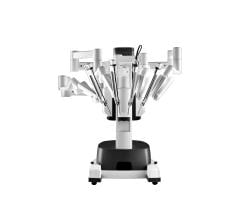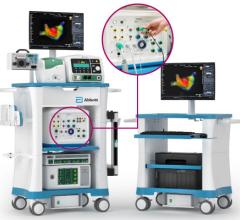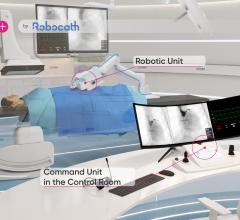April 30, 2008 - The surgeon working inside J.C. Bizzle's chest perched at an egg-shaped console a few yards from the operating table. Without laying hands on his patient, he bypassed two clogged arteries supplying Bizzle's heart.
The University of Chicago's Sudhir Srivastava, M.D., performed the surgery without a big incision, without splitting Bizzle's breastbone and without stopping his heart. The spider-like arms of a robot did most of the work.
Bizzle, 79, a retired crane operator, was discharged April 5, just three days after a double bypass that typically would land a patient in the hospital for a week or more. "I had very little pain," Bizzle says. "Before summer's end, I'm expecting to be out playing golf."
In a era when an increasing number of patients have been choosing balloon angioplasty to avoid the trauma of open-heart surgery, Dr. Srivastava is one of a handful of pioneers who are reinventing the bypass operation. The goal is to make bypass surgery almost as patient-friendly as angioplasty.
The timing couldn't be better. Robotic surgery is catching on. Angioplasty's popularity appears to have plateaued in the wake of studies indicating the procedure may be no better than optimal medical therapy. Robotic surgery also reflects a broader push to reduce the risk of infections and other complications, to shorten hospital stays and to get patients on their feet in days rather than weeks.
"Someday, we'll look back and think, 'My God, how brutal we were,' " says Valluvan Jeevanandam, M.D., chief of cardiac and thoracic surgery at the University of Chicago Medical Center.
Despite the advantages for patients, doctors have been slow to adopt robotic bypass surgery. It's a classic case in which the wonders of technology bump up against hard realities. There's the complexity of the procedure, a shortage of tech-savvy young surgeons willing to learn to perform it and too few patients to go around.
"It's terrific to say, 'Gee whiz, why don't I have a robotic operation when the alternative is taking a chain saw to my chest?' But there are too many places that won't have the volume or surgeons with the interest or expertise to make it a logical choice," says Bruce Fye, a Mayo Clinic heart specialist and medical historian.
Success hinges on the surgeon's ability to use robot technology designed by NASA and the Department of Defense and later adapted to minimally invasive surgery. Its makers call it the "da Vinci."
The da Vinci won federal approval in 2000, making it the only low-trauma surgical robot on the market. Since then, more than 867 have been installed at hospitals worldwide, 647 of them in the USA, at a cost of $1.5 million apiece, says the robot's maker, Intuitive Surgical. This year, doctors worldwide will perform roughly 130,000 da Vinci procedures, from bypasses to prostatectomies to hysterectomies, up from 85,000 last year, according to company estimates.
Most of those operations, 55,000, were prostate removals, a total expected to grow by 40 percent this year. The firm won't release specifics on bypass surgery or mitral valve repairs except to say they're relatively rare, but the volume is expected to grow by 30 percent to 35 percent this year, says Christopher Rabbitt, Intuitive's director of worldwide cardiovascular sales.
Dr. Jeevanandam says robotic surgery offers ambitious surgeons a way to compete for a shrinking number of patients.
Geoffrey Cousins of Charleston Medical Center in West Virginia says that's why he seized on the opportunity to do robotic bypasses. "We're (almost like) lawyers chasing ambulances," he says. "It's a pretty cutthroat business."
But there's a loftier reason as well, Cousins says. "I think, personally, that I'm riding the wave of the future in cardiac surgery."
Long day of surgery
Bizzle's day began early. By 7:30 a.m., physician assistant Reyna Barrera prepped him as he lay on a gurney, with his wife, Geraldine, at his side. By the time Dr. Srivastava arrives in the operating room, Bizzle is asleep. He has all but vanished under a sea of blue paper drapes; only his torso is visible under a protective plastic covering.
The operating room team of about 10 doctors, nurses, anesthesiologists, physician assistants and others is bigger than usual. But the surgery is more complex with different demands. For instance, a team of OR staffers will spend the next four hours defogging the camera lens and swapping robotic instruments in response to Srivastava's commands.
It starts with three small holes
At about 10:25 a.m., the surgeon cuts three small holes, each about half an inch in diameter, on the patient's left side. The fourth will come later when it's time to fasten the bypass grafts close to the heart. He places plastic tunnels into the holes to provide pathways for instruments. The upper and lower portals will carry a variety of robotic knives, pincers and cautery tools. The middle port carries the 3-D camera with its blinding light. The last hole will contain the latest technological advance: a suction device with a flat fork for stabilizing the still-beating heart as the grafts are fastened in place.
An anesthesia crew of four begins the procedure by deflating Bizzle's left lung to give Dr. Srivastava's robot elbowroom inside the chest. This turns out to be more complicated than it seems. Soon the lung springs back into the visual field, crowding out the instruments. It will take 20 minutes to deflate it and start the procedure again.
Sitting at his console, eyes fixed on a video monitor, Dr. Srivastava uses his fingertips to maneuver controls linked to four mechanical arms. Each arm is tipped with instruments that enter the patient's chest through the small holes he had created earlier. The surgeon uses a clutch pedal beneath his foot to disengage the robot arms while he's adjusting his position.
Watching the sweeping motion of the massive arms above the patient, it's hard to imagine how they're converted into tiny movements inside the chest. Yet video monitors ringing the room show the instruments moving with precision as Dr. Srivastava snips away two mammary arteries from inside the chest wall. Next he slits open the heart's protective covering, makes one incision at a time in the two clogged arteries on the heart's surface and cinches each bypass into place. "This is a lifeline for patients," he says. "It's not something that you want to rush."
By 2:17 p.m., it's over. Dr. Srivastava heads off to reassure Bizzle's wife that everything went well. "There'll be some soreness," he says, "but he should be able to do pretty much what he feels like doing."
Remarkable results
Dr. Srivastava began tinkering with robotic bypass surgery five years ago in the unlikeliest of places: a tiny 50-bed heart facility called Alliance Hospital that he owned in Odessa, Texas.
He learned to use sharp instruments on the heart's surface without the sense of touch that usually guides surgeons' movements. His eyes alone guide his movements.
The robotic results were remarkable, Dr. Srivastava says. "In the first beating-heart procedure I did in the U.S., the patient went home in 23 hours and drove (from Texas) to Arizona in one week," he says.
He's now done about 350 robotic bypasses, 60 in Chicago. "We've been able to complete the surgery in 99 percent of patients. Only twice have we had to split the sternum because of problems. We've had zero wound complications. Since you're not touching the sternum, there's no problem with healing."
Death rates dropped too, Dr. Srivastava says. "The average mortality for bypass surgery is 1.5 percent to 2 percent. Our mortality is 0.3 percent."
Dr. Srivastava participated in the only major attempt to weigh robotic surgery against the standard procedure. Researchers enrolled 98 patients at 12 centers in the USA and Europe.
None of the patients died, more than 90 percent had effective procedures, and only six needed follow-up operations, results that compare favorably with traditional bypass surgery. Even da Vinci enthusiasts acknowledge the study, out in 2006, isn't conclusive, because it involved so few patients and a historical control group.
Dr. Jeevanandam says he believed strongly enough in the surgery's potential to recruit Srivastava and give the university an edge in a town "oversaturated" with surgeons. Dr. Srivastava says the invitation offered him a once-in-a-lifetime opportunity to spread the gospel of robotic bypass surgery. "That's the vision," he says.
Dr. Jeevanandam laughs. "Why else would he give up his own hospital and the lovely climate of Odessa, Texas?"
Source: By Steve Sternberg, USA TODAY
For more information: http://www.usatoday.com/news/health/2008-04-29-robot-surgery_N.htm

 June 11, 2024
June 11, 2024 








